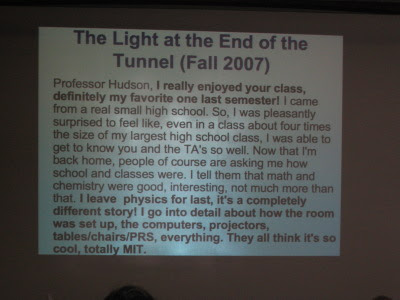After Comunicare Fisica 2010, the 3rd edition of the workshop about communication in physics, I decide to present you my notes about Peter Dourmashkin's talk:

Peter Dourmashkin at Comunicare Fisica
Dourmashkin presentation is very interesting. He speaks about a learning experiment in US classrooms: Dourmashkin himself enters in classroom to intercact with students and explain theory and experiments. For example, he proposes us a video with one oh his lessons: after the explanation to the board, he walks through the classroom in order to see stundents' activity, to quest and suggest reflections.
One of the most interesting slide is about the properties of
Learning Objects (LO):
- Create an engaging and technologically enabled active learning environment
- Move away from passive lecture/recitation format
- Incorporate hands-on experiments
- Enhance conceptual understanding
- Enhance problem-solving ability
In a broader definition of LO, we can add also the following properties:
- Develop communication skills in core sciences
- Develop collaborative learning
- Reduce gender gap
- Develop new teaching/learning resources
Must interesting is the rethinking about teaching roles instructor:
- graduate teaching assistants: learn to teach
- undergraduate teaching assistants: encourages student teaching
- students: peer instructors

Slide from Dourmashkin's presentation
He also proposes two examples of Learning Ojects: one to explain the Gauss's Law and the other to explain the Faraday's law. In the spirit of LO, they realize two intercat simulations. In the first case we can add charges, we can modify theyr positions, and see the modifications in electric field; in the second case we can change the spatial position of a couple of charges and see also the graphics about the properties of the systems.
Design the structure of the lessons is another very important point: for example we can structure the evaluation moment of our classroom activity using the following scheme (we must intend it like a classroom activity):
- Concept test
- Thinking
- Individual answer
- Peer discussion
- Revised/group answer
- Explanationtion
The presentation of the activity is realize with a classroom discussion, using the white board to introduce the mathematical details. Durgin the experiments, the students acquire data using laptop.
For instructional model, Dourmashkin proposes
Polya model:
- Getting starded - identify assumptions and givens
- Plan the approach - articulate a strategy that may involve multiple concepts and problem solving methodologies
- Execute the plan - does it work?
- Review - does the answer make sense?

Slide from Dourmashkin's presentation
In conclusion, the MIT Observes that
the gender gap disappears in TEAL learning; we can find motivation of it in the following points:
- Peer instructor
Ability to ask questions
- Many opportunities to practice problem solving
- Cooperative learning in a non-competitive learning environment
Some internet resources:
TEAL;
MIT Mathlets.




Nessun commento:
Posta un commento